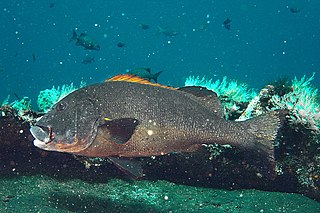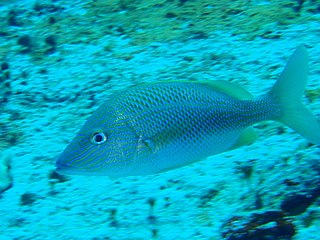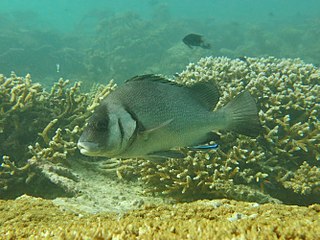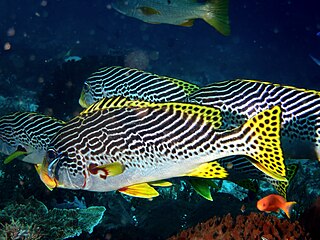
The Caesar grunt, also known as the black grunt, blacktail grunt, or redmouth grunt is a species of marine ray-finned fish, a grunt in the family Haemulidae. It is native to the western Atlantic Ocean

Plectorhinchus polytaenia, the ribboned sweetlips or yellow-ribbon sweetlips, is a species of marine ray-finned fish, a sweetlips belonging to the subfamily Plectorhinchinae, one of two subfamilies in the family Haemulidae, the grunts. It is native to the Indian Ocean and the western Pacific Ocean.

Plectorhinchus albovittatus, the two-striped sweetlips or giant sweetlips, is a species of marine ray-finned fish, a sweetlips belonging to the subfamily Plectorhinchinae, part of the grunt family Haemulidae. It is native to the Indian Ocean and the western Pacific Ocean.

Haemulon vittatum, the boga, is an ocean-going species of grunt native to the western Atlantic Ocean. Bogas are also known as the snit in Jamaica, and bonnetmouth in the Bahamas. It was first described by Cuban zoologist Felipe Poey. This species used to be classified as Inermia vittata, but genetic data revealed that it belongs to the genus Haemulon.

The bluestriped grunt, also known as the boar grunt, golden grunt, humpback grunt, redmouth grunt, or yellow grunt, is a species of marine ray-finned fish, a grunt belonging to the family Haemulidae. It is found in the western Atlantic Ocean.

Haemulon flavolineatum, the French grunt, banana grunt, gold laced grunt, open-mouthed grunt, redmouth grunt, or yellow grunt, is a species of marine ray-finned fish, a grunt belonging to the family Haemulidae. It is native to the western Atlantic Ocean.

Haemulon plumierii, the white grunt or common grunt, is a species of ray-finned fish in the family Haemulidae native to the western Atlantic Ocean. It grows to a length of about 30 cm (12 in) and is a silvery-cream color, with narrow yellow and blue longitudinal stripes, but can modify its color somewhat to match its surroundings. It is closely related to the bluestriped grunt and the French grunt, and often schools with these species. It feeds on shrimp, other crustaceans, annelids, and mollusks, and is preyed on by larger piscivores such as barracuda and shark. It is sometimes caught by anglers as a game fish, and its flaky white flesh can be eaten. It is also a popular aquarium fish.

The bigeye grunt, Brachydeuterus auritus, is a species of marine ray-finned fish, a grunt belonging to the family Haemulidae. It is native to the Atlantic coast of Africa.
The dara is a species of marine ray-finned fish, a grunt belonging to the family Haemulidae. It is native to the Atlantic coast of Africa. It is the only species in the monospecific genus Parakuhlia.

Xenocys jessiae, the black-striped salema, is a species of marine ray-finned fish, a grunt belonging to the family Haemulidae. It is endemic to the eastern Pacific Ocean.

Haemulon chrysargyreum, the smallmouth grunt, bronze grunt, or yellowstripe grunt, is a species of marine ray-finned fish, a grunt belonging to the family Haemulidae. It is found in the western Atlantic Ocean.

Haemulon scudderii, the grey grunt, golden-eye grunt, or mojarra grunt, is a species of marine ray-finned fish, a grunt belonging to the family Haemulidae. It is found in the eastern Pacific Ocean.

Pomadasys kaakan, the javelin grunter or barred javelin is a species of marine ray-finned fish, a grunt belonging to the family Haemulidae. It is native to the Indian and Pacific Oceans, from Africa to Australia.

Plectorhinchus gibbosus, commonly known as the Harry hotlips, black sweetlips, brown sweetlips, dusky sweetlips, gibbous sweetlips, hairy hotlips or humpback sweetlips, is a species of marine ray-finned fish, a sweetlips belonging to the subfamily Plectorhinchinae, one of two subfamilies in the family Haemulidae, the grunts. It is native to the Western Pacific and Indian Oceans.

Plectorhinchus lineatus also known as the yellowbanded sweetlips, oblique-banded sweetlips, diagonal-banded sweetlips, Goldman's sweetlips, lined blubber-lips, lined sweetlips, many-lined sweetlips, striped sweetlips and yellowband sweetlips, is a species of marine ray-finned fish, a sweetlips belonging to the subfamily Plectorhinchinae, one of two subfamilies in the family Haemulidae, the grunts. It inhabits coral reefs of the western Pacific Ocean, where it occurs at depths from 1 to 35 m.

Plectorhinchus gaterinus, commonly known as the blackspotted rubberlip or African grunt, is a species of marine ray-finned fish, a sweetlips belonging to the subfamily Plectorhinchinae, one of two subfamilies in the family Haemulidae, the grunts. It is found in the western Indian Ocean.

Conodon nobilis, the barred grunt, is a species of marine ray-finned fish, a grunt belonging to the family Haemulidae. It is found in the Western Atlantic Ocean where it is a target species for some commercial fisheries.

Pomadasys argenteus, the silver grunt, silver javelin, grunter bream, small-spotted grunter-bream, small-spotted javelin fish, trumpeter or white-finned javelin fish, is a species of marine ray-finned fish, a grunt from the family Haemulidae. This species has a wide Indo-Pacific distribution. It is the type species of the genus Pomadasys.

The African striped grunt is a species of marine ray-finned fish, a sweetlips belonging to the subfamily Plectorhinchinae, one of two subfamilies in the family Haemulidae, the grunts. It is found in the eastern Atlantic Ocean.

The rubberlip grunt is a species of marine ray-finned fish, a sweetlips belonging to the subfamily Plectorhinchinae, one of two subfamilies in the family Haemulidae, the grunts. It is native to the eastern Atlantic Ocean.




















